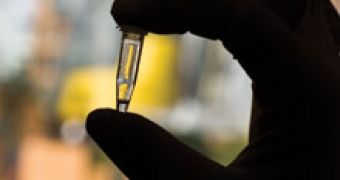We know that viruses 'produce' only diseases. But what if they could produce even ... devices?
A MIT team led by Angela Belcher, a professor of materials science and biological engineering, has managed to use viruses that cling together in a solution to form fibers several centimeters long and almost as strong as a strand of nylon. This is the first time viruses have been used for making nanomaterials.
The viruses can organize themselves, lining up side by side to make an orderly model and also they can be genetically engineered to attach to and control inorganic materials like those employed in battery electrodes, transistors and solar cells.
By aligning with other viruses, the viruses can form crystalline structures employed for making high-performance devices.
Belcher's team had already obtained virus-based thin films for rechargeable batteries. Now she looks for threadlike batteries and other electronic devices that can be turned directly into clothing.
"It's not really analogous to anything that's done now. It's about giving totally new kinds of functionalities to fibers." she said. U.S. Army already wants to incorporate future fibers into uniforms that could detect agents of chemical and biological warfare or capture sun energy to power portable electronic devices, like night-vision equipment.
"While such uniforms will probably take decades to develop, Belcher's work has paved the way for them," said Charlene Mello, a macromolecular scientist at the Natick Soldier Research, Development and Engineering Center in Natick, MA.
The team already uses different methods to obtain various types of virus fibers. A mutation of the virus DNA makes the proteins of the viral body to have extra copies of a specific amino acid at one end, making the protein glow in bright red when exposed to UV.
The team achieved quantum dots (semiconductor nanocrystals that emit intense light as a response to some wavelengths) with surface amine groups that attach to the overproduced amino acid. Hundreds of quantum dots gathered onto each virus make a fiber that emits light.
Belcher employed "directed evolution" to rapidly change viruses to attach to many materials: they added a randomly generated DNA stretch to each virus, encoding for a short protein (peptide) into the gene for a select protein. Due to many variations among the obtained viruses, some of them should randomly carry peptides attaching to a targeted inorganic material.
The viral solution is poured onto a target material, like a small square of gold, then the material is washed. Following a few repetitions, only the viruses that bind strongly remain. This way the team rapidly achieves viruses to attach to a particular material, even if they did not have before a DNA stretch known to work. The right viruses can be easily spun into a fiber.
To further strengthen the viral fiber, the team added a molecule to the solution that binds neighboring viruses to each other. The researchers want to make similar fibers into sensors, solar cells and batteries.
Two types of virus fibers can be achieved: one functioning as a negative battery electrode and another as a positive electrode. By twisting the two fibers together, with a polymer electrolyte in between, a rechargeable battery could be woven into uniforms.

 14 DAY TRIAL //
14 DAY TRIAL //